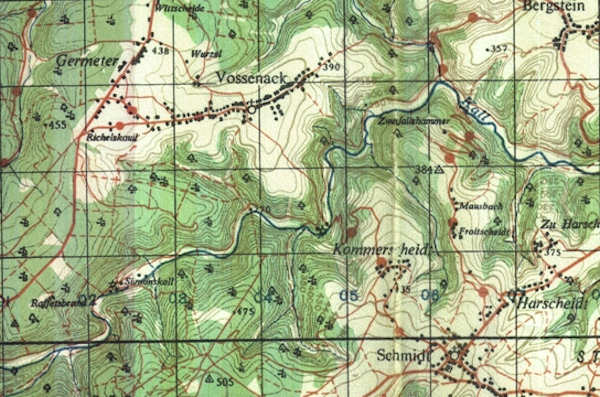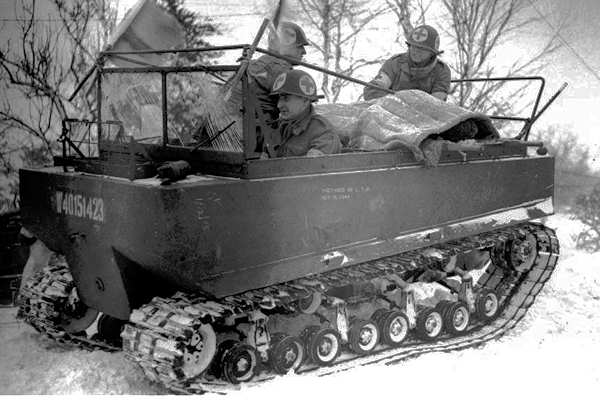in the Hurtgen Forest
Germany, 2 - 14 November 1944
(Rhineland Campaign)
THE TERRAIN
By Major Paul A. Troup, Jr.

The deep wooded ravines of the Huertgen Forest
In order that the reader may better understand the more detailed description of the action depicted in this monograph it is necessary to digress from the narrative so that a brief description of the terrain in the zone of operations of the 28th Division can be made.
Approximately 18 miles southeast of Aachen the "Forst Hurtgen" spreads itself through rugged terrain for more than 50 square miles. The dense growth of Douglas Fir toweres from 75 to 100 feet above the blanket of pine needles which concealed the damp ground. The closely packed trees formed a natural umbrella through which only a few of the suns rays would penetrate on the brightest days. The Kall River unwound itself through the deep wooded ravines of the forest until it disappeared into the waters of the Roer River. The towns are founded on the tree thinned ridges which rise out of the west end of the forest. The Hurtgen - Bergstein and Schmidt - Steckenborn ridges not only command by observation the Kall Valley and Vossenack but on the north they dominate the beginning of the Cologne Plain, the Roer River and on the south they hold the key to the large Roer River dams; both vital areas in the scheme of maneuvers of the Allied Armies. The road net crossing the Kall River consisted of a few trails that resembled cork screws when viewed on a map. Although the combination of woods, terrain, and road net made an attack through this area not very feasible; control of it was a definite military necessity. 5

Cut out of map used in 1944.
THE PROVISIONS OF THE ATTACK
It was evident that because of the known hazardous elements of the terrain this mission would be extremely difficult; therefore, in planning It was essential that the following provisions were as thoroughly established as humanly possible before the attack could be launched:
- Favorable weather was vital since this would be basically an infantry attack and isolation of the local battlefield had to be maintained to prevent the enemy from counterattacking with his armored reserves. The intensive studies of aerial photographs and other sources of information by the G-2 revealed no verification of the existence of a road or trail from Vossenack through the Valley of the Kall River to Kommerscheidt; therefore, very little help from friendly armor could be counted on.
- Artillery would have to be in adequate strength so that it could effectively neutralize the observation and possible artillery positions that would be located on the Hurtgen — Bergstein and Schmidt — Steckenborn ridges, the commanding terrain features in the zone of the attack.
- To cope with the problem of supply and evacuation, cargo carriers that could transverse the steep sides of the Kall River Valley had to be procured. To overcome this predetermined obstacle the division requested and received 47 cargo carriers, full track, commonly known as "Weasels". 7

M29 "Weasel"
THE DIVISION PLAN OF ATTACK
With three infantry regiments on line, the 28th Infantry Division commander, Major General Norman "Dutch" Cota assigned them the following missions: (See Map B-1)
- 109th Infantry Regiment attacks north to secure the Germeter-Hurtgen road and the adjacent wooded area to the clearing southwest of the town of Hurtgen. Thus in addition to protecting the north flank of the division this objective would serve as a line of departure for the US 4th Infantry Division in its forthcoming attack with the VII Corps.
- 110th Infantry Regiment attacks south to secure the Kall River west of Schmidt.
- 112th Infantry Regiment attacks east to capture Vossenack after which time the regiment will change its direction of of attack to the southeast on the line Vossenack - Kommerscheidt - Schmidt and capture and secure Schmidt. 8
The enemy order of battle opposing this attack as depicted by G-2 of V Corps on 011800 October 1944 was as follows:
• 275th Infantry Division
- 141st Fortress Battalion
- 20th GAF Fusilier Battalion
- Kampfgruppe Wegelein
• 275th Fusilier Battalion
• 1412nd Infantry Battalion.
• 89th Fusilier Battalion
• Kampfgruppe Trier
Reserves identified:
• Kampfgruppe Brandes
• Kampfgruppe Feind
• 73rd Engineer Battalion
• 275th Engineer Battalion 9
The specific course of the attack of the 112th Infantry as decided by Lt. Col. Carl Peterson, the commanding officer, was without a doubt the most logical plan that could be conceived under the circumstances of the mission given in the division order. He was aided in the preparation of the order by an able staff which included the newly assigned Executive Officer, Lt. Col, Locket, who had served as a battalion commander in this area when the US 9th Infantry Division attacked in the early days of October. Thus after the evaluation of all the available information and after the best possible solution to the problem of supply and evacuation had been reached the following plan was given to the subordinate commanders: 10
The 2nd Battalion commanded by Lt. Col. Hatzfield with Company "D" of the 707th Tank Battalion attached would attack Germeter and Vossenack. Upon the seizure of the objective the battalion would organise a defensive position. The line of departure would be the present front line which at this date was approximately 200 yards west of Germeter.
Immediately after the capture of Vossenack the 3rd Battalion commanded by Lt. Col. Flood would attack southeast across the Kall River to capture Kommerscheidt and Schmidt. The battalion would then organise a defensive position to secure Schmidt.
The 1st Battalion commanded by Major Hazlett would follow the 3rd Battalion and after the capture of Kommerscheidt the 1st Battalion would move into the town and secure it.
In addition to the neutralization of the key terrain features that commanded the battlefield, the commanders of the battalions of artillery that were in direct support plus the supporting artillery battalions of the VII Corps were ordered to give the attack an artillery preparation which would start one hour before the jump off. 11
The stage was set for the attack to begin on the 31st of October 1944 but due to unfavorable weather and an inadequate supply of ammunition it was cancelled until the 1 November only to be postponed again until the 2nd of November. Starting on the 29 October the 8th AAF bombed towns in the vicinity but these attacks were hampered by the prevailing bad weather consequently the results were not as good as anticipated. The enemy air effort was confined to night reconnaissance and bombing for which they paid the price of two aircraft which the supporting anti-aircraft shot down. The artillery supported by the attached Tank-Destroyers and Anti-aircraft (90 mm guns) continued active on counter-battery, harassing, and interdictory missions. 12

